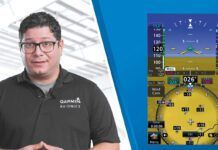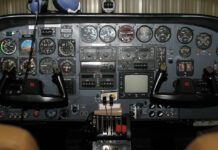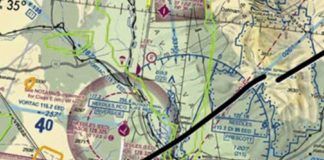Most pilots I know are lazy. Writing as one who has spent most of his career flying airplanes, that’s meant to be a compliment. The lazy pilot tends to accomplish the least work necessary in order to achieve the intended goal. This usually improves workload management and provides a greater reserve of attention. However, sometimes laziness can get you into trouble, such as in determining when to intercept and track a glidepath.
When cleared for an approach with vertical guidance (ILS, LPV, etc.), it’s common for pilots to stay level until they intercept the glidepath, with the mistaken belief that the glidepath will cross at or above any stepdown fixes prior to the FAF. The alternative would be to dive-and-drive all the way to the FAF, and only then to intercept the glidepath. This method seems like it would be extra work—the bane of the lazy pilot—not to mention pointless, since you’ll cross the FAF at the same altitude using both methods.
Except that this method isn’t pointless, although it certainly can be more work. Unfortunately, it’s the only way to use a glidepath that’s guaranteed to keep your ticket in your pocket as well as keep you from hitting things.
Don’t Put Your Plates Down Yet
The final segment of an approach with vertical guidance starts at the point at which the glidepath passes through the glidepath intercept altitude, known as the precise FAF (PFAF). This point is identified on AeroNav charts by the lightning bolt symbol, and by the beginning of the feather symbol on Jeppesen charts. Even though the glidepath can be received outside of the PFAF, it effectively only exists between the PFAF and the runway.
Outside of the PFAF, stepdown fix altitudes are determined on the basis of obstacle clearance and air traffic requirements, just like every other type of approach. The glidepath angle may be considered in determining stepdown fix altitudes in the intermediate segment, leading up to the PFAF, but that isn’t required. The optimal descent gradient in the intermediate segment is actually shallower than the typical glidepath angle, which is why the glidepath often passes above intermediate segment stepdown fix altitudes. However, this shouldn’t be assumed, because it isn’t always the case.
A classic example of why this shouldn’t be assumed can be found on the ILS RWY 6 approach into Teterboro, New Jersey. This procedure features a mandatory altitude of 1,500 at DANDY, as shown by the lines above and below the altitude. If a pilot were to descend on the glidepath instead, he would cross DANDY at about 1,965 feet, certainly drawing unwanted attention from New York TRACON. This scenario plays out quite regularly with the jet jocks going into Teterboro.
Mandatory altitudes are easy to spot on approach plates. More troublesome are intermediate segment stepdown fixes that were computed using a steeper than normal descent gradient. These visually blend in with all the other minimum altitudes depicted on the procedure. On these approaches, such as the ILS RWY 4R into Chicago O’Hare, joining the glidepath early would result in crossing stepdown fixes below the charted minimum altitude.
Additionally, altimetry errors can cause aircraft following the glidepath outside of the PFAF to fail to adhere to published stepdown fix altitudes. Since aircraft altimeters are calibrated at standard temperature, any deviation from standard temperature will result in an error. In practice, nonstandard temperatures affect all aircraft equally, so all aircraft at an indicated altitude will still be on the same horizontal plane, even though the true altitude of that plane shifts with temperature.
On the other hand, a glideslope (other than Baro-VNAV) is constant and unaffected by temperature. The potential problem arises because stepdown fix altitudes are published using indicated altitudes that vary with temperature, but altitudes along a glideslope are unaffected by temperature. The result is that on a hot day on the glidepath, your pressure altimeter will indicate lower over a fix than on a cold day, and you might bust that crossing altitude. Since the glideslope is constant, you won’t be closer to obstacles, but it might result in air traffic separation issues if stepdown fix altitudes are ignored.
Established On What?
Another potential source of misunderstood pilot expectations comes from the ATC approach clearance phraseology. When vectoring an aircraft for an ILS, a controller will issue an approach clearance that goes something like “N12345, fly heading 120, maintain 3,000 until established, cleared ILS runway 15 approach.” This raises the question of what does “established” mean? Many pilots tend to interpret this to mean stay at 3,000 until established on the glidepath.
Other times the approach clearance will include “…until established on the localizer [or final approach course],” which makes the controller’s expectations clearer. AIM 5-4-7(b) tells us that when given a radar vector, the pilot should maintain the last assigned altitude until established on a segment of a published procedure. Once established, “published altitudes apply to descent within each succeeding route or approach segment unless a different altitude is assigned by ATC.”
In this regard, a procedure with a glidepath is no different than a procedure without a glidepath. Nowhere is it suggested that the pilot should join the glidepath at the intercept vector altitude. Instead, once established on the final approach course, and on a published approach segment, pilots are expected to descend to the glideslope intercept altitude or the appropriate stepdown fix altitude.
It’s “Intercept” For a Reason
The FAA is well aware of pilot misunderstandings on this topic. In 2011, they published an advisory notice to air carriers (InFO 11009) in which “pilots are cautioned to adhere to published step-down fixes located outside the Final Approach Segment on an ILS approach.” Additionally, AIM 5-4-5(b) was updated that year to include note stating that “interception and tracking of the glide slope prior to the published glide slope interception altitude does not necessarily ensure that … altitudes published for any preceding fixes will be complied with during the descent.” So, enough of us have done it wrong that the FAA is warning us.
It might seem a bit counterintuitive and contrary to the stabilized approach concept to exchange a potential descent with vertical guidance for dive-n-drive methods on an approach. There is no arguing that stabilized approaches are beneficial, but just like the recent discussion in this magazine about the hazard of following a derived glidepath below MDA, they can sometimes get us into trouble when used improperly. Stabilized approaches are a final approach concept, and the final approach doesn’t begin until the PFAF. Therefore, although a constant descent rate outside of the PFAF is certainly convenient, stabilized approaches aren’t necessarily appropriate at that stage of an approach.
If there are no intermediate stepdown fixes or air traffic instructions to the contrary, there’s no harm in joining the glidepath early and enjoying a stabilized descent all the way down. However, if there are any stepdown fixes prior to the PFAF, you can’t assume that the glidepath will enable you to clear them. Unfortunately, there’s no practical way to determine whether or not an early descent on the glidepath will satisfy intermediate stepdown fix altitude requirements other than continuing to cross-check your approach plate during the descent.
Lee Smith, ATP/CFII, is an aviation consultant, flight instructor and charter pilot in Northern Virginia.




